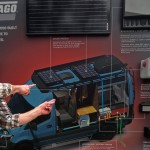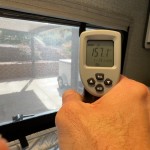This post may contain affiliate links.
I know I’m supposed to be working on the tank additive experiments now (and I am, I promise), but when I had the idea for this detour, I couldn’t resist.
I’m sure we’ve all heard that advice at one time or another to dump a bag of ice into the RV black tank to “scrub it out” or “knock things loose”. On the surface, it makes sense. But does it really work? I had to find out.
Since I had the black tank simulator, and my old pickup truck, I put this advice to the test. By the way, I love that truck – I’ve had it since 1987! Anyway, I constructed a rig to hold the tank still in the truck while I drove around, and I put two cameras on it. I even got a camera INSIDE the tank to catch the action. I went with a purple simulated waste this time, using one of the new recipes based on a paper by NASA scientists. (Yes, they have scientists that develop simulated waste.) After that, it was buy some ice and drive around for an hour or so.
But did it work?
Short answer: Maybe kind of, but not really all that great.
I wanted to go all “Myth-Busters” on it and declare the old advice a hoax, but in the end, you can get a very limited scrubbing action with the ice cubes. But that comes with a few caveats.
1: You have to drive your RV like a demon
I drove my truck like a madman. Even with that, I was unsuccessful in getting the ice very far up the sides of the tank, or in completely knocking all the waste off. You WOULD NOT drive your RV like I was driving. Trust me. And even so, in the video, you’re just seeing the highlights. Most of the time, the ice just sat there.
2: You have to use the right amount of ice
If you put too much ice in the tank, it will kind of pack itself in, and not move at all. You want enough to cover the bottom, and then a little bit more than that. But the trouble is, most of us can’t see into the black tank to know how much that is.
3: You have to use the right amount of water
You want the ice moving, but not floating. If the ice is floating, well, it’s floating, and anything underneath the ice is just soaking. If soaking is what you’re going to do, then even room temperature water is more effective than ice water.
4: Even if you do everything right, it’s pretty darn weak
Scrubbing works on abrasion, but ice and water is a very low-friction environment. The ice just doesn’t smack into things very hard. Most of the time, the stuck on waste was pushing the ice, and not the other way around. Now, you might be able to improve on that by freezing up a solid block of ice that you can get down the toilet. But by the time you’re making special three pound ice cubes that you can fit down your RV toilet… well I’m just going to say you’re going too far.
By now, I’ve seen enough of these experiments to know that most of the cleaning action you saw was just due to the water, and not the ice. In fact, if you really had some stuff baked on in there, you’d be better off going the other way, and pouring HOT water down the tank. Think about it: you’ve never seen anyone try to clean a casserole dish by putting ice cubes in it, because everyone knows it won’t work. This is no different.
So what’s my take?
If you need to clean stuck on material out your black tank, and you don’t have an in-tank rinsing system – save your money, save your ice, and save your gas. Just soak it. It will work just as well.
Enjoy the video. This one is only 8 minutes long!! (And Stef’s in it, so it’s prettier than my usual videos.)











I’d like to see this same setup with the other reported solutions, adding Dawn or adding automatic dishwasher detergent, to a ½ or more full tank. Seeing is so much better than just reading about it.
Bring back your assistant, your son. I’m sure he would have been a lot of help.
As I am new to the RV / Travel Trailer world. i am hearing all of the myths. when I spotted this, I watched it.
I appreciate what you did but from what I understand from others is, you would use this at the end of a trip to break up solid or suspended waste.
so,
1. Black tank at 1/2 or 3/4 full at ambient temperature.
2. Toilet paper and battle ship size turds floating or just under the surface from our constipated Sh*t a brick friends. (Wife)
3. Put Ice in that is left over from the end of the weekend boondocking (Ice makers or just coolers full of Ice
4. Drive back to RV dump in 2hrs away
5. ice will melt quicker in hotter ambient temperature areas then in Northern Canada in October causing more volume of water so more shushing in tank.
6. with the ice sloshing about it will break up large floaties, paper and cause a ll the sinkable waste that is stuck in the floaties to sink. Basically making a milk shake effect which is easier to clear out the tank instead of block tanks as the wife uses 20 sheets per wipe.
from what i was told it wasn’t there to scrub the tank but to break up the big things that float or is just under the surface.
I’ve never heard that ice was intended to break up “floaters”. I’ve always heard that it was to remove, or “scrub” stuck on residue… so that’s what I tested.
I can’t imagine it would be very effective at all on the former. You could test that out yourself pretty easily. Dump an Ice Cream Float into a bowl or pan and slosh it about. The ice cream will melt before the ice cubes smash it apart.
This was pure Stef-and-James; it did not disappoint. I WAS curious, and now I know. Thanks, guys
I think this was done incorrectly , if you put 20 lbs of ice in a partially full tank it would definitely slosh all around while moving much harder than in a stagnant test in a dry tank which seems like it was set up to fail anyway. It’s sort of like using large salt crystals to remove stains in old bottles. You put salt in the bottle WITH some water and shake vigorously. It really does work. I believe a large amount of ice in a partially full tank would do the same as the ice would be free to slosh around and bash into all the particles. Just my take on it. Dan
Like the info, keep it up.
P.s. Love the music sound track, what is it?
Hi George! It’s actually an original! James is a musician, and he and his buddy Kyle recorded it in our basement music studio! Kyle is an amazing guitarist….James did drums and bass. Pretty much any music you hear on any of our videos was James’ own stuff, unless the YouTube blurb states otherwise. I’m sure he’s thrilled for the compliment!!!
Hey James
your Videos Are Cool And Very Helpful. What Is The Simulated Waste recipe? Keep RV’in!
Austin
I had to buy it from the SAE! You can find the recipe here: http://papers.sae.org/2006-01-2180/
Great test. I tried the ice trick twice during a 7K mile trip. Did not help at all. Sensors still don’t work.
I enjoyed the ice cube video. I also heard the same thing works using dishwasher liquid soap. let me know if you ever try that test. I’ll be checking out your other stuff. thanks.
I do plan to eventually test tank additives. As soon as I finish, and can move the woodworking project out of my shop, I’ll be back on that. The GEO method (dish soap and water softener) is on the list for testing.
Cheers!
None of these tests address the tank sensor ” build-up” problem at all. If your 3/4 mark sensor ( for. Example) is clogged, you have to at least fill tank to nearly that depth for any ice-scrubbing to do any meaningful work. Next, comes the type of ice used and thirdly, the quantity of ice needed to do the job.
I suggest the larger pellet size. Also a twenty pound bag at least. These holding tanks have maybe three / to four times the square footage water surface area than the “test” tank illustrated. You need the ice to melt slowly ( fractured multi size pieces will melt very fast). You can assure a two inch depth of ice might be capable of a range of maybe 8-10 inches in rise and fall “scrubbing action” on the sidewalls ( where level monitoring sensors are positioned). It’s more real life circumstance experiment needed to address the “clogged sensor” error that so many of us rv’ers are having fits with.
Interesting hypotheses.
We’ll eagerly await your video!
Hi James,
Great look at an old RV’ing myth!
Just for fun, I’d like to take isseu with this statement:
“you’ve never seen anyone try to clean a casserole dish by putting ice cubes in it, because everyone knows it won’t work.”
No, but people DO use solid CO2 “ice” to clean rocket parts:
http://www.coldjet.com/en/industries/aerospace.php
The whole idea:
http://www.coldjet.com/en/information/what-is-dry-ice-blasting.php
I was using liquid CO2 for accelerated cooling in temperature cycling chambers over 35 years ago and that is when I learned about CO2 bead blasting, a very cool cleaning technology that I did not need…
I’m not advocating the use of solid CO2 of course, since I am in the “Who Cares?’ camp when it comes to cleaning my black and grey tanks. I just wanted to bring up a counterpoint to your “ices cubes in the casserole dish”
If anyone is really concerned about getting accurate readings on tank level, then a through-the-tank sensor system is really the only reasonable way to go. No electrodes to get mucked up and so nothing to clean.
Thanks again for the great work and documnentation on some of the myths in the Dark Side of RVing!
Hey Tom! The dry ice blasting sounds interesting. I want one.
I have no idea what I’d do with it, but a dry ice blasting gun just seems like an awesome thing to have.
And I completely agree with you on the tank sensors. I put them on Das Bus. I don’t know why manufacturers even bother with the probes anymore.
James,
Does the misses ever question your actions? LOL
Every day, Dave… Every day…
OK my observation, small tank, it should have been bigger,not enough room for the ice to really get moving, close to the size of a regular holding tank. Next, the ice that was purchased was ROUND, and did a lot of ROLLING, and no scraping as ice cubes would have thus not doing the job. Good theory, but inconclusive as far a results is concerned.
my pennie’s worth.
Nivram,
Actually, the clear holding tank is approximately the same dimensions as the tank in my class B – it’s only a few inches smaller in width. The additional speed that ice might pick up in that couple inches would be more than negated by the fact that nobody would actually drive their RV the way I was driving that truck. The lateral, longitudinal, and sometimes even vertical acceleration I was putting on that tank is far greater than anything you’d ever get with a real RV. That ice was moving more and faster than anything in anyone’s actual RV tank, ever.
As to the square vs. round ice cubes… Uh… really? I’m watching slow-motion video of the ice right now, and it is tumbling and sliding. There may be some rolling, but it’s completely at random. For something to “roll” there needs to be enough friction on one surface to cause the rolling. There’s just not enough friction between ice and water (or between ice and the film of water on a piece of waste) to consistently cause anything to roll. And even if you don’t believe that, the ice cubes were cylindrical and not spheres (at least, the ones that weren’t broken), meaning they all had at least some edges.
I don’t think either of the things you mentioned would have changed the results of the experiment. You are, of course, free to continue to put ice down your tank, if you really believe in it. If you were able to get some razor-sharp square ice cubes, and get them REALLY moving – say, from a musket blast, then you might be on to something. I’d be happy to help you test that theory, but we’ll have to use your rig. 😉
Keep up the good work.
Interesting that you actually went to (all the trouble) to prove this idea is a waste of time.
I always thought ice was just too wimpy to do much in a RV tank.
Your truck bed test is a (great idea) and that truck certainly is more choppy than any RV suspension I am aware of.
You have put another MYTH down the toilet!
Thanks Kip. What drew me to this experiment was the thought of tearing around town with cameras rolling on a clear tank of simulated waste and ice in the back of the truck. It was too ridiculous to pass up!
Not that I wanted you to get pulled over, but can imagine the dialogue with the officer if you had been pulled over?
Too funny Mark! That would have been amusing. And you KNOW I would have kept the cameras rolling!